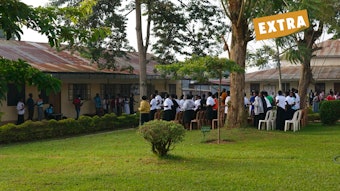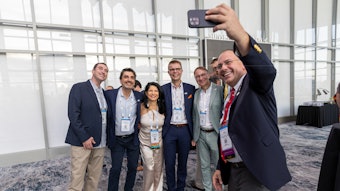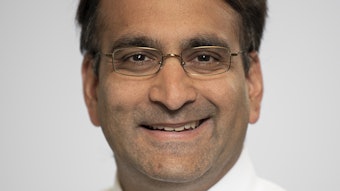Treating Hearing Loss in Cases of Vestibular Schwannoma
Effective treatment for patients with hearing loss and vestibular schwannoma have evolved, improving quality of life.
Edward J. Doyle, III, MD, Saangyoung E. Lee, MD, Ksenia A. Aaron, MD, and Kevin D. Brown, MD, on behalf of the Implantable Hearing Devices Committee

Traditional teachings held that retrocochlear pathology prevented meaningful benefit from cochlear implantation (CI). This thinking began to shift in the late 1980s and early 1990s. Arriaga and Marks described simultaneous tumor removal and CI, establishing the feasibility of CI as an immediate form of auditory rehabilitation in this population.1 CI was used frequently in multiple neurofibromatosis type 2 (NF-2) studies, where CI was implanted while cerebellopontine tumor was continually either observed or removed, demonstrated better open-set speech scores when compared with outcomes observed after auditory brainstem implantation (ABI).2–4 This provided the groundwork that led to increasing use of CI as an established modality in hearing restoration in patients with spontaneous vestibular schwannoma.
Maintenance of hearing is a realistic goal following tumor resection in cases of smaller tumors. Historically, this has been achieved with conservation of native acoustic hearing following tumor removal by a middle fossa or retrosigmoid approach. More recently, and especially since approval of single-sided deafness as an indication for CI, maintenance of hearing can be achieved by placement of a cochlear implant in an ear that has/has had a VS. CI in the setting of VS can be performed in three situations: in an observed, nongrowing tumor, following radiation therapy of a tumor, and after tumor resection with conservation of the cochlear nerve.
Observation
Conservative management has become more popular over the last two decades. Our understanding of the natural course of these tumors has improved, especially smaller tumors.5–7 Small tumors, particularly those found intrameatally, have been shown to have low growth rates, making them particularly good candidates for observation, unless the patient’s vestibular status precludes observation.8 In these cases, if hearing rehabilitation is desired, a cochlear implant can be placed without removing a previously demonstrated nongrowing tumor. In the absence of potential iatrogenic trauma to the cochlear nerve, hearing outcomes have generally been better than other treatment modalities for patients, with open-set speech perception at 100% as well as word recognition scores ranging from 52% to 72%, AzBio scores in quiet up to 75%, and 55% CNC scores.9–11
Patients who receive a cochlear implant in this situation show a history of stable tumor size, but a history of unchanging size does not preclude future tumor growth.12,13 Observation necessitates close surveillance to monitor for interval growth. Existing concerns include image quality of MRI in this population. Thoughtful placement of the receiver-stimulator in an exaggerated superior-posterior position can decrease artifact and improve visualization of the internal auditory canal and the cerebellopontine angle.14 Contemporary cochlear implants are also MRI-conditional and have been shown to be safe in 1.5- to 3-Tesla machines.
Tumor progression after cochlear implantation is challenging to manage in a manner that maintains existing cochlear implant status. An implant in the field would likely need to be removed and the electrode used as a placeholder for interval re-implantation, although there is consideration of using the implant for intraoperative electrically evoked auditory brainstem response testing to monitor the cochlear nerve.15 If radiotherapy were pursued to control a growing tumor, implant artifact could limit accurate simulation and therapy and necessitate explantation.16
Microsurgery
Hearing conservation if sufficient acoustic hearing is present, or effective rehabilitation of insufficient hearing loss present pre-operatively or following surgery, is often a critical consideration for patients. Although many patients may have hearing preserved during surgery, others may lose hearing despite a hearing-preservation approach, even with gross preservation of the cochlear nerve intra-operatively.17 Concurrent or sequential CI with VS microsurgical resection has been shown to be a safe and effective way to provide hearing rehabilitation.18,19 Benefits of this include improved sound localization, tinnitus suppression, and improved quality of life.18,19 Although speech outcomes with cochlear implants after microsurgery may be the most variable among treatment modalities, there is still demonstrated open-set speech understanding to 61% and median monosyllabic word recognition scores at 11%.10,20 CNC scores were found to be 18% compared to standard CI controls at 68.5%.11 There is also an added benefit that after microsurgical resection of a small tumor, there is virtually no risk of recurrence providing both patient and surgeon peace of mind that a future surgery will not be necessary.21,22
Though CI can be performed safely with microsurgical tumor resection, there is a possibility for auditory nonstimulation despite intraoperative cochlear nerve preservation.11 Following microsurgical resection, patients require significantly higher neural response telemetry to T- and C- levels than conventional CI recipients, reflecting reduced neural function.11 Though hearing outcomes are equivocal between simultaneous and sequential CI, a delayed implantation can come with added challenges including secondary anesthesia, distorted anatomy, or cochlear fibrosis.17 The risk of cochlear fibrosis is progressive; 25% of patients have some degree of obliteration at six months and 73% to 86% have fibrosis at one to two years post-operatively.23,24 This risk can be ameliorated by placing a dummy electrode in the cochlea at the time of tumor resection to maintain a patent cochlea.
Radiation Therapy
A recent multicentered retrospective review showed that ipsilateral CI after observation or stereotactic radiosurgery (SRS) yielded more reliable speech reception than microsurgical resection. Dornhoffer et al. reported that among 100 sporadic VS cases who underwent ipsilateral CI, open-set speech understanding was up to 80% after SRS and median monosyllabic word recognition scores were 30%.10 This was further echoed in a single-center retrospective review comparing programming and performance metrics between standard CI control and VS patients with average CNC word recognition scores being 44% after radiation compared to standard CI controls at 68.5%.11
In contrast to microsurgery, stimulation levels after radiation/observation were higher, but not significantly different.11 A systematic review by Schlacter supported these findings, demonstrating that patients with observed and irradiated VS had similar postoperative CNC scores 45.4% and 44.4% respectively.25 The superior CI outcomes after SRS over microsurgery are attributed to less cochlear nerve injury. This has been attained by optimizing the ideal dose to the tumor and establishing the importance of keeping the cochlear dose low.26–30
In a meta-analysis of hearing preservation after SRS, Balossier found that of VS patients treated with SRS (single fraction), ~60% preserved hearing rate at 6.7 years, and Santa Maria showing 26% preservation at 10 years.31,32 However, CI performance is not static and can be expected to wane and decline with time. Robust long-term data is not available for CI recipients with spontaneous VS. Young’s review of SR- treated VS found that while 79.2% achieved open set speech, 20% still experienced implant failure.33 Seventy-five percent of patients in this group were patients with NF-2. Failure was divided into three categories: immediate nonfunction, delayed failure, and loss of tumor control with subsequent device removal. It is also notable that similar to observation, radiation therapy does not address vestibular symptoms.
Conclusions
CI has been shown to be a safe and effective treatment for patients with VS, regardless of treatment modality. Observation or SRS can offer a better opportunity for subsequent CI outcomes than microsurgical resection, albeit with risk of future tumor growth and no control of vestibular symptoms. The potential for progressive nerve degeneration, or even tumor regrowth/recurrence, must all be considered in shared decisionmaking. Our knowledge of the longevity of hearing improvement with CI is limited by the paucity of long-term data in these small cohorts, hence ongoing collection of these studies is essential to better define candidacy and guide patients in their hearing restoration journey.
References
- Arriaga MA, Marks S. Simultaneous cochlear implantation and acoustic neuroma resection: imaging considerations, technique, and functional outcome. Otolaryngol Head Neck Surg. 1995;112(2):325-328. doi:10.1016/s0194-5998(95)70257-1
- Lustig LR, Yeagle J, Driscoll CLW, Blevins N, Francis H, Niparko JK. Cochlear implantation in patients with neurofibromatosis type 2 and bilateral vestibular schwannoma. Otol Neurotol. 2006;27(4):512-518. doi:10.1097/01.mao.0000217351.86925.51
- Vincenti V, Pasanisi E, Guida M, Di Trapani G, Sanna M. Hearing rehabilitation in neurofibromatosis type 2 patients: cochlear versus auditory brainstem implantation. Audiol Neurootol. 2008;13(4):273-280. doi:10.1159/000115437
- Carlson ML, Breen JT, Driscoll CL, et al. Cochlear implantation in patients with neurofibromatosis type 2: variables affecting auditory performance. Otol Neurotol. 2012;33(5):853-862. doi:10.1097/MAO.0b013e318254fba5
- Stangerup S-E, Caye-Thomasen P, Tos M, Thomsen J. The natural history of vestibular schwannoma. Otol Neurotol. 2006;27(4):547-552. doi:10.1097/01.mao.0000217356.73463.e7
- Stangerup S-E, Tos M, Caye-Thomasen P, Tos T, Klokker M, Thomsen J. Increasing annual incidence of vestibular schwannoma and age at diagnosis. J Laryngol Otol. 2004;118(8):622-627. doi:10.1258/0022215041917989
- Carlson ML, Habermann EB, Wagie AE, et al. The Changing Landscape of Vestibular Schwannoma Management in the United States--A Shift Toward Conservatism. Otolaryngol Head Neck Surg. 2015;153(3):440-446. doi:10.1177/0194599815590105
- Reznitsky M, Petersen MMBS, West N, Stangerup S-E, Cayé-Thomasen P. The natural history of vestibular schwannoma growth-prospective 40-year data from an unselected national cohort. Neuro Oncol. 2021;23(5):827-836. doi:10.1093/neuonc/noaa230
- Longino ES, Manzoor NF, Cass ND, et al. Cochlear implantation outcomes in observed vestibular schwannoma: A preliminary report. Otolaryngol Head Neck Surg. 2022;167(1):149-154. doi:10.1177/01945998211045903
- Dornhoffer JR, Marinelli JP, Lohse CM, et al. Comparing Cochlear Implant Outcomes in 100 Patients With Sporadic Vestibular Schwannoma Managed With Observation, Radiosurgery, or Microsurgery: A Multi-Institutional Review. Otol Neurotol. 2024;45(10):e719-e726. doi:10.1097/MAO.0000000000004298
- Kolberg C, Bogle J, DeJong MD, et al. Impact of vestibular schwannoma management on cochlear implant programming and outcomes. Otol Neurotol. 2025;46(8):903-908. doi:10.1097/MAO.0000000000004572
- Lees KA, Tombers NM, Link MJ, et al. Natural history of sporadic vestibular schwannoma: A volumetric study of tumor growth. Otolaryngol Head Neck Surg. 2018;159(3):535-542. doi:10.1177/0194599818770413
- Macielak RJ, Patel NS, Lees KA, et al. Delayed tumor growth in vestibular schwannoma: an argument for lifelong surveillance. Otol Neurotol. 2019;40(9):1224-1229. doi:10.1097/MAO.0000000000002337
- Schwartz N, Rooth MA, Dillon MT, et al. MRI surveillance following concurrent cochlear implantation in cases of vestibular schwannoma resection. Am J Otolaryngol. 2020;41(4):102518. doi:10.1016/j.amjoto.2020.102518
- Lassaletta L, Polak M, Huesers J, et al. Usefulness of electrical auditory brainstem responses to assess the functionality of the cochlear nerve using an intracochlear test electrode. Otol Neurotol. 2017;38(10):e413-e420. doi:10.1097/MAO.0000000000001584
- Nader M-E, Gidley PW. Challenges of Hearing Rehabilitation after Radiation and Chemotherapy. J Neurol Surg B Skull Base. 2019;80(2):214-224. doi:10.1055/s-0039-1677865
- Wick CC, Butler MJ, Yeager LH, et al. Cochlear implant outcomes following vestibular schwannoma resection: systematic review. Otol Neurotol. 2020;41(9):1190-1197. doi:10.1097/MAO.0000000000002784
- Sanna M, Medina MDM, Macak A, Rossi G, Sozzi V, Prasad SC. Vestibular Schwannoma Resection with Ipsilateral Simultaneous Cochlear Implantation in Patients with Normal Contralateral Hearing. Audiol Neurootol. 2016;21(5):286-295. doi:10.1159/000448583
- Rooth MA, Dillon MT, Brown KD. Prospective Evaluation of Patients Undergoing Translabyrinthine Excision of Vestibular Schwannoma with Concurrent Cochlear Implantation. Otol Neurotol. 2017;38(10):1512-1516. doi:10.1097/MAO.0000000000001570
- Conway RM, Tu NC, Sioshansi PC, et al. Early outcomes of simultaneous translabyrinthine resection and cochlear implantation. Laryngoscope. 2021;131(7):E2312-E2317. doi:10.1002/lary.29436
- Ahmad RARL, Sivalingam S, Topsakal V, Russo A, Taibah A, Sanna M. Rate of recurrent vestibular schwannoma after total removal via different surgical approaches. Ann Otol Rhinol Laryngol. 2012;121(3):156-161. doi:10.1177/000348941212100303
- Carlson ML, Link MJ. Vestibular Schwannomas. N Engl J Med. 2021;384(14):1335-1348. doi:10.1056/NEJMra2020394
- Carswell V, Crowther JA, Locke R, Taylor W, Kontorinis G. Cochlear patency following translabyrinthine vestibular schwannoma resection: implications for hearing rehabilitation. J Laryngol Otol. 2019;133(7):560-565. doi:10.1017/S0022215119001087
- Hill FCE, Grenness A, Withers S, Iseli C, Briggs R. Cochlear patency after translabyrinthine vestibular schwannoma surgery. Otol Neurotol. 2018;39(7):e575-e578. doi:10.1097/MAO.0000000000001858
- Schlacter JA, Kay-Rivest E, Nicholson J, et al. Cochlear implantation outcomes in patients with retrocochlear pathology: A systematic review and pooled analysis. Otol Neurotol. 2022;43(9):980-986. doi:10.1097/MAO.0000000000003648
- Paek SH, Chung H-T, Jeong SS, et al. Hearing preservation after gamma knife stereotactic radiosurgery of vestibular schwannoma. Cancer. 2005;104(3):580-590. doi:10.1002/cncr.21190
- Hasegawa T, Kida Y, Kato T, Iizuka H, Yamamoto T. Factors associated with hearing preservation after Gamma Knife surgery for vestibular schwannomas in patients who retain serviceable hearing. J Neurosurg. 2011;115(6):1078-1086. doi:10.3171/2011.7.JNS11749
- Govindaraj R, Khong J, Byrne A, Zacest A, Roos D. The Effect of Cochlear Dose on Hearing Preservation After Low-Dose Stereotactic Radiosurgery for Vestibular Schwannomas: A Systematic Review. Adv Radiat Oncol. 2022;7(6):101059. doi:10.1016/j.adro.2022.101059
- Kondziolka D, Lunsford LD, McLaughlin MR, Flickinger JC. Long-term outcomes after radiosurgery for acoustic neuromas. N Engl J Med. 1998;339(20):1426-1433. doi:10.1056/NEJM199811123392003
- Flickinger JC, Kondziolka D, Niranjan A, Lunsford LD. Results of acoustic neuroma radiosurgery: an analysis of 5 years’ experience using current methods. J Neurosurg. 2001;94(1):1-6. doi:10.3171/jns.2001.94.1.0001
- Balossier A, Tuleasca C, Delsanti C, et al. Long-Term Hearing Outcome After Radiosurgery for Vestibular Schwannoma: A Systematic Review and Meta-Analysis. Neurosurgery. 2023;92(6):1130-1141. doi:10.1227/neu.0000000000002354
- Santa Maria PL, Shi Y, Gurgel RK, et al. Long-Term Hearing Outcomes Following Stereotactic Radiosurgery in Vestibular Schwannoma Patients-A Retrospective Cohort Study. Neurosurgery. 2019;85(4):550-559. doi:10.1093/neuros/nyy407
- Young K, Grewal MR, Diaz RC, Wu AW, Miller ME. Cochlear Implantation after Stereotactic Radiosurgery for Vestibular Schwannoma: Initial Hearing Improvement and Longevity of Hearing Restoration. Otol Neurotol. 2023;44(3):201-208. doi:10.1097/MAO.0000000000003815
















